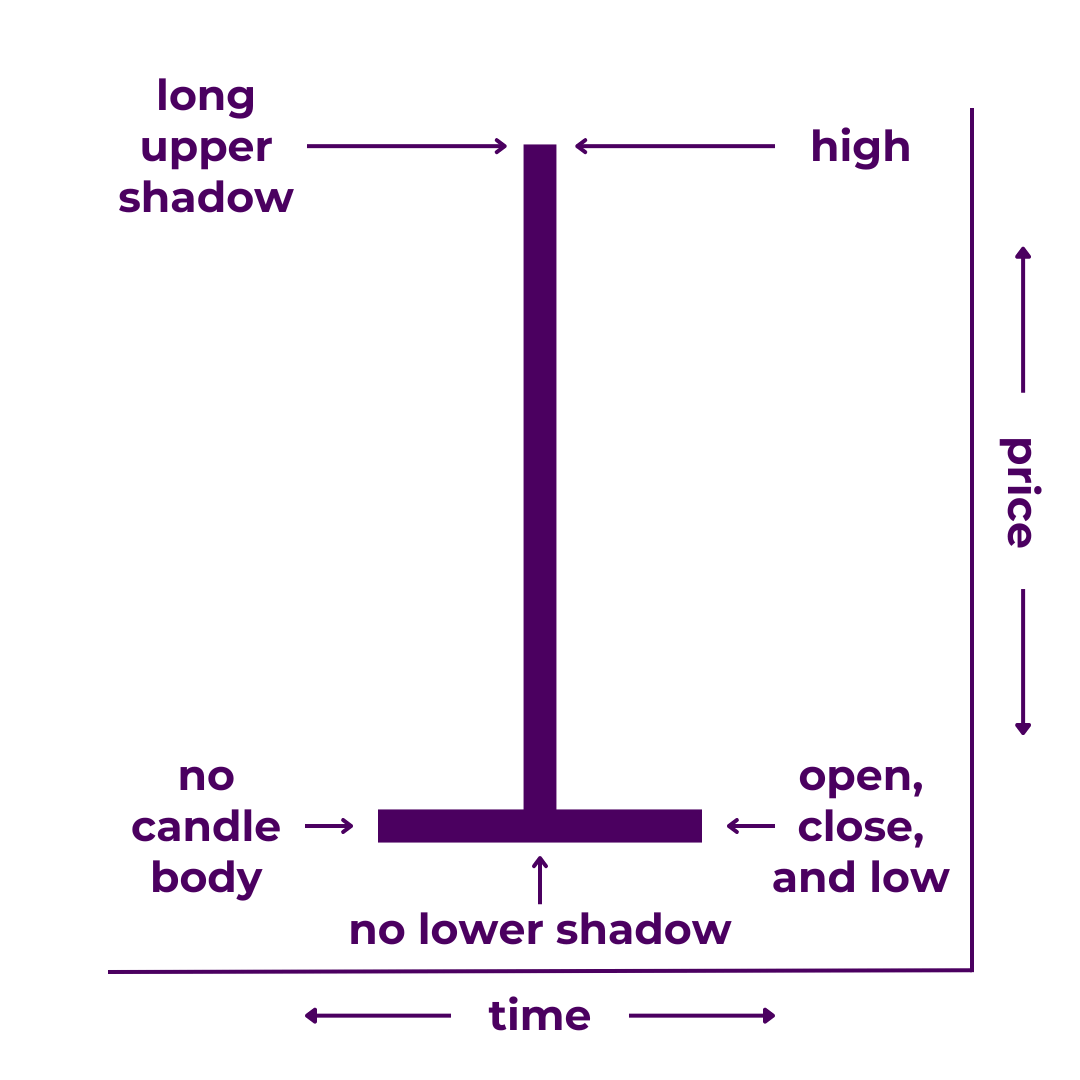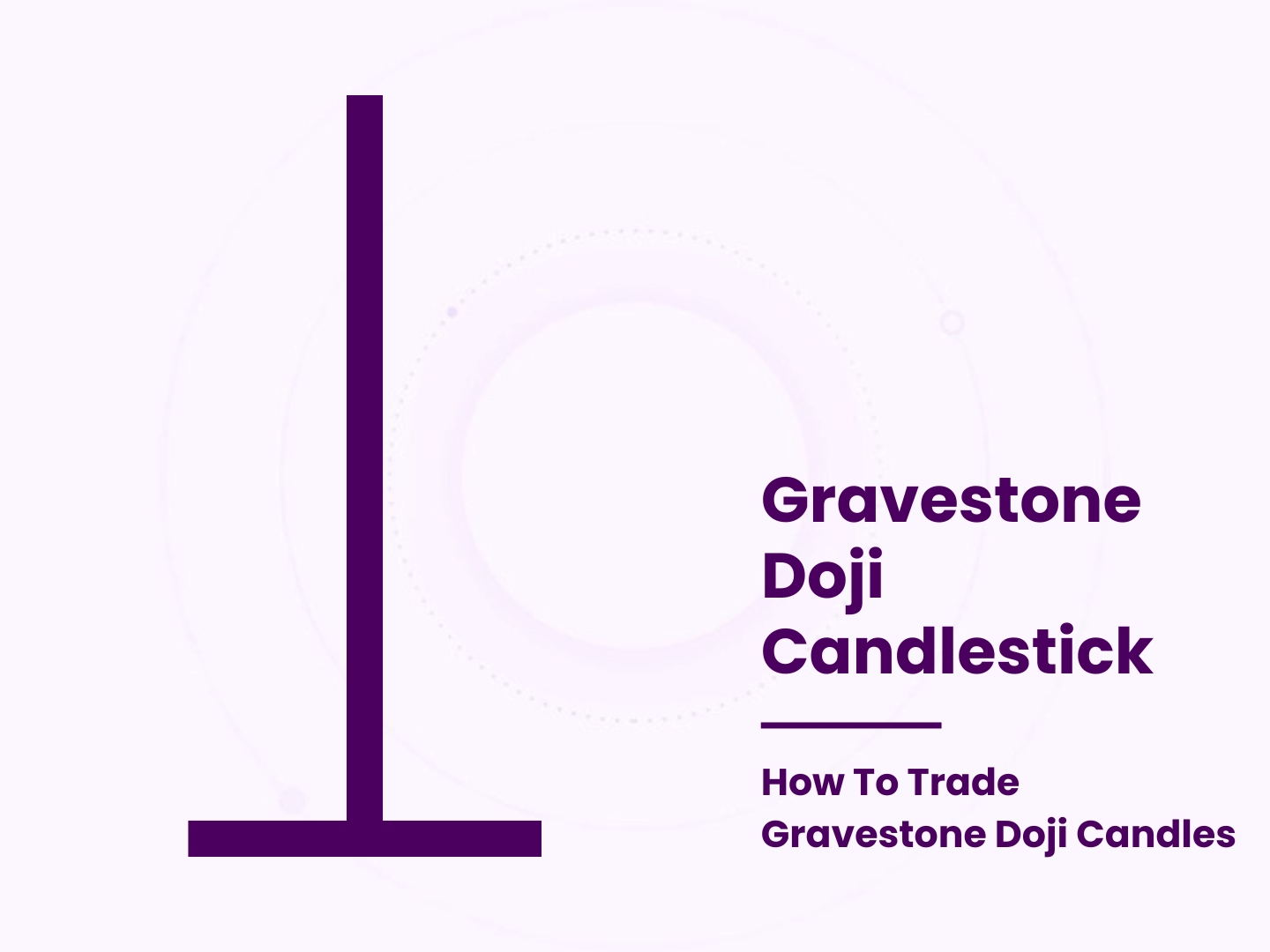Gravestone Doji candlesticks are one of the most famous types of candlesticks for good reason.
Japanese candlesticks are the basic building block of most technical analysis. That makes the ability to recognize different candlestick types a crucial trading skill.
In this Guide to Gravestone Doji Candlesticks, we’ll explain:
First though, let’s start with a definition.
What Is a Gravestone Doji Candlestick?
A gravestone doji is a candlestick with no real body, no lower shadow, and a long upper shadow. It indicates that open and close prices are the same and at the bottom of the trading range. Gravestone doji are commonly seen during topping formations, reversals, trending moves, and volatile periods.

The gravestone doji candlestick is a sub-type of doji, and the opposite of the dragonfly doji.
Doji means “the same thing” in Japanese. This comes from the fact that the open and close are exactly the same. The gravestone part comes from the look of the candlestick and its connotation. The candle body is the ground, the upper wick is the gravestone, and it suggests that price is going into the dirt. In trading terms, a gravestone doji candle signals bearish momentum.
Gravestone doji paint a picture of a dead price walking. Without a candle body, the long upper wick usually stands out most. On the chart, it looks like the bears are ready to win the tug-o-war. Meanwhile, the bulls cling on for dear life, crying, “Not yet!”
Technically, doji should have the exact same opening and closing prices. In practical application though, “perfect” gravestone doji are comparatively rare. If the body is insignificant, you can treat it like a doji (though it may arguably be an inverted hammer or similar). Regardless if the body is small or non-existent, the implications are generally the same.
As we’ll get into shortly, context is more important than exact criteria anyway.
More on how to trade gravestone doji candles in a moment.
First, let’s illustrate how they are formed.
How Are Gravestone Doji Candles Formed?
Gravestone doji give the impression of a bearish comeback.
That impression is usually correct.
Within the time period of the candle, price rose higher then dropped back down to end up exactly where it began. Thus, a gravestone doji on a daily chart implies that the bulls fought back to reclaim the day. However, the candlestick probably took on various shapes before closing as a gravestone doji.
You’d need shorter timeframes to see a more complete picture.
That’s also why you should usually wait for confirmation. It’s not officially a gravestone doji until the candle closes. And it can be dangerous to make trades based on incomplete candles.
You can never be 100% sure how a candlestick will look at the end of the time period.
That’s one of the reasons it’s so important not to get too focused on any single candle.
Where Gravestone Doji Candlesticks Fit in the Chart Narrative
The markets are often characterized as a battle between the bulls and the bears.
Gravestone doji indicate that the fight is fierce but the bulls may be on the verge of taking control. Obviously, no single candlestick can determine an entire trend. Still, gravestone doji are one of the few candlesticks that give a very strong directional bias.
Be on the lookout for them during:
- Tops – Gravestone doji are one of the easiest-to-spot indications of potential local highs and topping formations.
- Reversals – Gravestone doji candlesticks are often seen in and around reversal formations, especially bearish ones.
- Trending Moves – Sometimes, gravestone doji appear due to a failed attempt by the bulls to push back against a bearish trend.
- Volatile Periods – Dramatic doji like dragonfly, gravestone, and long-legged tend to form when volatility is at its highest.
They may also appear in certain types of candlestick patterns.
To become a successful trader, understanding candlesticks is a great place to start. But you should also learn how candlestick patterns and chart patterns work. Plus, you need to be able to recognize cycles, trends, and price levels. From there, you can begin to read the story in the charts.
Tools like chart markup and trading indicators can reveal even more. And once you’ve chosen your asset(s) and trading style, the full chart narrative truly comes into focus. The charts will basically speak to you at this point.
By looking at the history of the chart, you can identify how price action played out around prior gravestone doji candles (or patterns that included them). Moreover, you can compare historical structures in price and your other tools to current price action.
Now, you’re actually doing real technical analysis.
How To Trade Gravestone Doji Candles
You should never trade based on a single candlestick.
However, certain candle shapes may give you some trading ideas, especially given the right context. Gravestone doji candlesticks are one of those shapes.
In addition to the overall structure surrounding a gravestone doji, there are some other things worth paying attention to.
- Trading Volume – The greater the trading volume during any candlestick’s formation, the greater its potential implications on price action.
- Lower Shadow – The longer the wick of a gravestone doji, the more likely it is to set in a strong bullish bias and/or establish resistance.
- Price Formations – Gravestone doji often appear along the top of various bearish price structures, such as descending triangles.
Generally, the fewer of these factors that are present, the less noteworthy the candle.
In order to form a complete trading strategy, you need to understand the basic math of trading, order types, and trading psychology. Even more importantly, you need to develop your own edge and learn risk management. And if you really want to take it all the way, look into options and trading automation.
Before you get there though, there’s still more to learn about the candles themselves.
Other Types of Candlesticks
You’d be wise to get familiar with all of the other ones too.
- Bearish Belt Hold
- Bullish Belt Hold
- Doji
- Dragonfly Doji
- Hammer
- Hanging Man
- Inverted Hammer
- Long Candle
- Long-Legged Doji
- Marubozu
- Shooting Star
- Spinning Top
Not all candlesticks shapes earn names—so you should probably check out the ones that do. Just keep in mind that it’s not necessarily about memorizing all of the ins-and-outs of each. It’s more about ingraining the principles of price action into your brain.
In fact, you’re free to forget all of the names as long as you can look at a candlestick and understand what it means.
Takeaways
To review:
Gravestone doji candlesticks are a type of candlestick that signals a momentum swing in favor of the bearss. They tend to show up during topping formations, reversals, trending moves, and periods of high volatility. That means they can help you find winning trades.
Of course, there are other types of candlesticks that you should learn about. And even so, candlestick analysis alone is not enough to trade successfully.
Nonetheless, you’ve now added one more tool to your toolkit.
Have questions or more information to add? Contribute to the conversation in the comments below! Or, if you know someone who could benefit from this post, share it with them. You can also check out our Japanese Candlesticks Guide to improve your candlestick analysis skills.


0 Comments